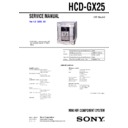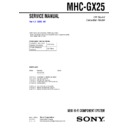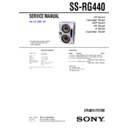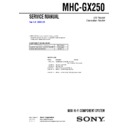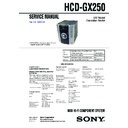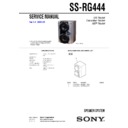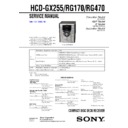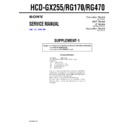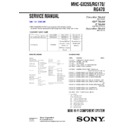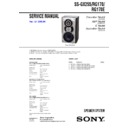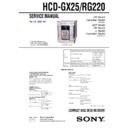Read Sony HCD-GX25 / MHC-GX25 Service Manual online
1
Ver 1.0 2003. 03
Model Name Using Similar Mechanism
NEW
CD
CD Mechanism Type
CDM74F-K6BD72
Section
Optical Pick-up Name
KSM-213DCP
Tape deck Model Name Using Similar Machanism
NEW
Section
Tape Transport Mechanism Type
CWM43FF-05
SERVICE MANUAL
US Model
HCD-GX25
Amplifier section
Continuous RMS power output (reference)
120+120 watts (6 ohms at
1 kHz, 10% THD)
1 kHz, 10% THD)
Total harmonic distortion
less than 0.07%
(6 ohms at 1 kHz, 60W)
(6 ohms at 1 kHz, 60W)
Inputs
GAME INPUT AUDIO L/R (phono jacks):
GAME INPUT AUDIO L/R (phono jacks):
voltage 250 mV,
impedance 47 kilohms
impedance 47 kilohms
GAME INPUT VIDEO (phono jack):
1 Vp-p, 75 ohms
Outputs
PHONES (stereo mini jack):
PHONES (stereo mini jack):
accepts headphones of
8 ohms or more
8 ohms or more
VIDEO OUT (phono jack):
max. output level 1 Vp-p,
unbalanced, Sync negative,
load impedance 75 ohms
unbalanced, Sync negative,
load impedance 75 ohms
SPEAKER:
accepts impedance of 6 to
16 ohms
16 ohms
SPECIFICATIONS
CD player section
System
Compact disc and digital
audio system
audio system
Laser
Semiconductor laser
(
(
λ=780 nm)
Emission duration:
continuous
continuous
Frequency response
2 Hz – 20 kHz (±0.5 dB)
Wavelength
780 – 790 nm
Signal-to-noise ratio
More than 90 dB
Dynamic range
More than 90 dB
Tape deck section
Recording system
4-track 2-channel stereo
Frequency response
50 – 13,000 Hz (±3 dB),
using Sony TYPE I
cassette
using Sony TYPE I
cassette
Sony Corporation
Home Audio Company
Published by Sony Engineering Corporation
9-877-125-01
2003C0400-1
© 2003. 03
– Continued on next page –
MINI HIFI COMPONENT SYSTEM
• HCD-GX25 is the tuner, deck, CD
and amplifier section in MHC-
GX25.
GX25.
2
HCD-GX25
SAFETY-RELATED COMPONENT WARNING!!
COMPONENTS IDENTIFIED BY MARK
0
OR DOTTED LINE
WITH MARK
0
ON THE SCHEMATIC DIAGRAMS AND IN
THE PARTS LIST ARE CRITICAL TO SAFE OPERATION.
REPLACE THESE COMPONENTS WITH SONY PARTS WHOSE
PART NUMBERS APPEAR AS SHOWN IN THIS MANUAL OR
IN SUPPLEMENTS PUBLISHED BY SONY.
REPLACE THESE COMPONENTS WITH SONY PARTS WHOSE
PART NUMBERS APPEAR AS SHOWN IN THIS MANUAL OR
IN SUPPLEMENTS PUBLISHED BY SONY.
Tuner section
FM stereo, FM/AM superheterodyne tuner
FM tuner section
Tuning range
87.5 – 108.0 MHz
Antenna
FM lead antenna
Antenna terminals
75 ohm unbalanced
Intermediate frequency 10.7 MHz
AM tuner section
Tuning range
530 – 1,710 kHz (with the tuning
interval set at 10 kHz)
Antenna
AM loop antenna
Antenna terminals
External antenna terminal
Intermediate frequency 450 kHz
General
Power requirements
120 V AC, 60 Hz
Power consumption
120 watts
Dimensions (w/h/d)
Approx. 280
× 325 × 407 mm
Mass
Approx. 8.5 kg
Supplied accessories:
AM loop antenna (1)
Remote Commander (1)
Batteries (2)
FM lead antenna (1)
Speaker pads (8)
Remote Commander (1)
Batteries (2)
FM lead antenna (1)
Speaker pads (8)
Design and specifications are subject to change without
notice.
notice.
To Exposed Metal
Parts on Set
Parts on Set
0.15µF
1.5k
Ω
AC
voltmeter
(0.75V)
voltmeter
(0.75V)
Earth Ground
Fig. A. Using an AC voltmeter to check AC leakage.
SAFETY CHECK-OUT
After correcting the original service problem, perform the following
safety check before releasing the set to the customer:
Check the antenna terminals, metal trim, “metallized” knobs, screws,
and all other exposed metal parts for AC leakage. Check leakage as
described below.
safety check before releasing the set to the customer:
Check the antenna terminals, metal trim, “metallized” knobs, screws,
and all other exposed metal parts for AC leakage. Check leakage as
described below.
LEAKAGE TEST
The AC leakage from any exposed metal part to earth ground and
from all exposed metal parts to any exposed metal part having a
return to chassis, must not exceed 0.5 mA (500 microamperes).
Leakage current can be measured by any one of three methods.
from all exposed metal parts to any exposed metal part having a
return to chassis, must not exceed 0.5 mA (500 microamperes).
Leakage current can be measured by any one of three methods.
1. A commercial leakage tester, such as the Simpson 229 or RCA
WT-540A. Follow the manufacturers’ instructions to use these
instruments.
instruments.
2. A battery-operated AC milliammeter. The Data Precision 245
digital multimeter is suitable for this job.
3. Measuring the voltage drop across a resistor by means of a VOM
or battery-operated AC voltmeter. The “limit” indication is 0.75
V, so analog meters must have an accurate low-voltage scale. The
Simpson 250 and Sanwa SH-63Trd are examples of a passive
VOM that is suitable. Nearly all battery operated digital
multimeters that have a 2V AC range are suitable. (See Fig. A)
V, so analog meters must have an accurate low-voltage scale. The
Simpson 250 and Sanwa SH-63Trd are examples of a passive
VOM that is suitable. Nearly all battery operated digital
multimeters that have a 2V AC range are suitable. (See Fig. A)
3
CAUTION
Use of controls or adjustments or performance of procedures
other than those specified herein may result in hazardous
radiation exposure.
other than those specified herein may result in hazardous
radiation exposure.
HCD-GX25
NOTES ON HANDLING THE OPTICAL PICK-UP BLOCK
OR BASE UNIT
OR BASE UNIT
The laser diode in the optical pick-up block may suffer electrostatic
breakdown because of the potential difference generated by the
charged electrostatic load, etc. on clothing and the human body.
During repair, pay attention to electrostatic break-down and also
use the procedure in the printed matter which is included in the
repair parts.
The flexible board is easily damaged and should be handled with
care.
breakdown because of the potential difference generated by the
charged electrostatic load, etc. on clothing and the human body.
During repair, pay attention to electrostatic break-down and also
use the procedure in the printed matter which is included in the
repair parts.
The flexible board is easily damaged and should be handled with
care.
NOTES ON LASER DIODE EMISSION CHECK
The laser beam on this model is concentrated so as to be focused on
the disc reflective surface by the objective lens in the optical pick-
up block. Therefore, when checking the laser diode emission,
observe from more than 30 cm away from the objective lens.
the disc reflective surface by the objective lens in the optical pick-
up block. Therefore, when checking the laser diode emission,
observe from more than 30 cm away from the objective lens.
Laser component in this product is capable
of emitting radiation exceeding the limit for
Class 1.
of emitting radiation exceeding the limit for
Class 1.
Notes on Chip Component Replacement
• Never reuse a disconnected chip component.
• Notice that the minus side of a tantalum capacitor may be
• Notice that the minus side of a tantalum capacitor may be
damaged by heat.
Flexible Circuit Board Repairing
• Keep the temperature of soldering iron around 270°C during
repairing.
• Do not touch the soldering iron on the same conductor of the
circuit board (within 3 times).
• Be careful not to apply force on the conductor when soldering
or unsoldering.
MODEL IDENTIFICATION
– BACK PANEL –
PARTS No.
MODEL
PARTS No.
US models
4-244-697-01
4
TABLE OF CONTENTS
1. GENERAL
Main Unit ................................................................................ 5
Remote Control ....................................................................... 6
Remote Control ....................................................................... 6
2. DISASSEMBLY
2-1. Case (Top) ........................................................................... 8
2-2. CD Door .............................................................................. 8
2-3. Front Panel Section ............................................................. 9
2-4. CD Mechanism Block ....................................................... 10
2-5. Tape Mechanism Deck ...................................................... 10
2-6. Panel Board, 1 Stream Led Board, Remote Board ............ 11
2-7. Game Jack Board, H/P Jack Board ................................... 11
2-8. Back Panel Section ............................................................ 12
2-9. Main Board ....................................................................... 12
2-10. Amp Board ........................................................................ 13
2-11. Driver Board, Sw Board .................................................... 13
2-12. CD Block Assy .................................................................. 14
2-13. Sensor Board ..................................................................... 14
2-14. Motor (TB) Board ............................................................. 15
2-15. Motor (LD) Board ............................................................. 15
2-16. Optical Pick-up ................................................................. 16
2-2. CD Door .............................................................................. 8
2-3. Front Panel Section ............................................................. 9
2-4. CD Mechanism Block ....................................................... 10
2-5. Tape Mechanism Deck ...................................................... 10
2-6. Panel Board, 1 Stream Led Board, Remote Board ............ 11
2-7. Game Jack Board, H/P Jack Board ................................... 11
2-8. Back Panel Section ............................................................ 12
2-9. Main Board ....................................................................... 12
2-10. Amp Board ........................................................................ 13
2-11. Driver Board, Sw Board .................................................... 13
2-12. CD Block Assy .................................................................. 14
2-13. Sensor Board ..................................................................... 14
2-14. Motor (TB) Board ............................................................. 15
2-15. Motor (LD) Board ............................................................. 15
2-16. Optical Pick-up ................................................................. 16
3. DIAGRAMS
3-1. IC Pin Description ............................................................. 17
3-2. Circuit Boards Location .................................................... 19
3-3. Printed Wiring Boards –CD Mechanism Section (1/2)– ... 21
3-4. Printed Wiring Boards –CD Mechanism Section (2/2)– ... 22
3-5. Schematic Diagram –CD Mechanism Section– ................ 23
3-6. Printed Wiring Boards –Main Section– ............................ 24
3-7. Schematic Diagram –Main Section (1/3)– ........................ 25
3-8. Schematic Diagrams –Main Section (2/3)– ...................... 26
3-9. Schematic Diagram –Main Section (3/3)– ........................ 27
3-10. Printed Wiring Boards –Panel Section– ............................ 28
3-11. Schematic Diagram –Panel Section– ................................ 29
3-12. Printed Wiring Board –Power Amp Section– ................... 30
3-13. Schematic Diagram –Power Amp Section (1/2)– ............. 31
3-14. Schematic Diagram –Power Amp Section (2/2)– ............. 32
3-15. Printed Wiring Board –Transformer Section– .................. 33
3-16. Schematic Diagram –Transformer Section– ..................... 34
3-17. IC Block Diagrams ............................................................ 35
3-2. Circuit Boards Location .................................................... 19
3-3. Printed Wiring Boards –CD Mechanism Section (1/2)– ... 21
3-4. Printed Wiring Boards –CD Mechanism Section (2/2)– ... 22
3-5. Schematic Diagram –CD Mechanism Section– ................ 23
3-6. Printed Wiring Boards –Main Section– ............................ 24
3-7. Schematic Diagram –Main Section (1/3)– ........................ 25
3-8. Schematic Diagrams –Main Section (2/3)– ...................... 26
3-9. Schematic Diagram –Main Section (3/3)– ........................ 27
3-10. Printed Wiring Boards –Panel Section– ............................ 28
3-11. Schematic Diagram –Panel Section– ................................ 29
3-12. Printed Wiring Board –Power Amp Section– ................... 30
3-13. Schematic Diagram –Power Amp Section (1/2)– ............. 31
3-14. Schematic Diagram –Power Amp Section (2/2)– ............. 32
3-15. Printed Wiring Board –Transformer Section– .................. 33
3-16. Schematic Diagram –Transformer Section– ..................... 34
3-17. IC Block Diagrams ............................................................ 35
4. EXPLODED VIEWS
4-1. Main Section ..................................................................... 37
4-2. Front Panel Section ........................................................... 38
4-3. Main Board Section .......................................................... 39
4-4. CD Mechanism Deck Section (1) ..................................... 40
4-5. CD Mechanism Deck Section (2) ..................................... 41
4-6. Optical Pick-up Section ..................................................... 42
4-2. Front Panel Section ........................................................... 38
4-3. Main Board Section .......................................................... 39
4-4. CD Mechanism Deck Section (1) ..................................... 40
4-5. CD Mechanism Deck Section (2) ..................................... 41
4-6. Optical Pick-up Section ..................................................... 42
5. ELECTRICAL PARTS LIST
........................................ 43
HCD-GX25

